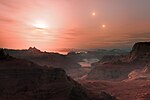| Observation data Epoch J2000 Equinox J2000 | |
|---|---|
| Constellation | Cygnus |
| Right ascension | 01 37 40.87964 |
| Declination | +12° 04′ 42.1742″ |
| Characteristics | |
| Spectral type | G3 |
| Astrometry | |
| Proper motion (μ) | RA: −0.150 mas/yr Dec.: −2.872 mas/yr |
| Parallax (π) | 0.6929 ± 0.7043 mas |
| Details | |
| Mass | 1 M☉ |
| Radius | 1.2 R☉ |
| Temperature | 5,755 K |
| Metallicity | +0.09 ± 0.04 dex |
| Age | 4.9 Gyr |
| Other designations | |
| Kepler-84, KOI-1589, Gaia DR2 2073776859551124992, KIC 5301750, 2MASS J19530049+4029458 | |
| Database references | |
| SIMBAD | data |
| ARICNS | data |
Kepler-84 is a Sun-like star 3,339 light-years from the Sun. It is a G-type star. The stellar radius measurement has a large uncertainty of 48% as in 2017, complicating the modelling of the star. The Kepler-84 star has two suspected stellar companions. Four red dwarfs are few arcseconds away and at least one is probably gravitationally bound to Kepler-84. Another (which is a background star with a probability 0.5%) is a yellow star of mass 0.855M☉ on projected separations of 0.18±0.05″ or 0.26″ (213.6 AU).
Planetary system
Kepler-84 is orbited by five known planets, four small gas giants and a Super-Earth. Planets Kepler-84b and Kepler-84c were confirmed in 2012 while the rest was confirmed in 2014. To keep the known planetary system stable, no additional giant planets can be located within 7.4 AU from the parent stars.
| Companion (in order from star) |
Mass | Semimajor axis (AU) |
Orbital period (days) |
Eccentricity | Inclination | Radius |
|---|---|---|---|---|---|---|
| b | 0.126±0.038 MJ | 0.083 | 8.725854±0.00006 | 0 | 88.24° | 0.174±0.045 RJ |
| c | 0.064±0.037 MJ | 0.108 | 12.882525±0.000093 | 0 | 88.24° | 0.184±0.047 RJ |
| d | — | 0.052 | 4.224537±0.000042 | — | — | 0.123±0.024 RJ |
| e | — | 0.181 | 27.434389±0.000224 | — | — | 0.232±0.044 RJ |
| f | — | 0.25 | 44.552169±0.000812 | — | — | 0.196±0.038 RJ |
References
- ^ "Kepler-84". SIMBAD. Centre de données astronomiques de Strasbourg. Retrieved July 13, 2016.
- ^ Vidotto, A. A; Gregory, S. G; Jardine, M; Donati, J. F; Petit, P; Morin, J; Folsom, C. P; Bouvier, J; Cameron, A. C; Hussain, G; Marsden, S; Waite, I. A; Fares, R; Jeffers, S; Do Nascimento, J. D (2014). "Stellar magnetism: Empirical trends with age and rotation" (PDF). Monthly Notices of the Royal Astronomical Society. 441 (3): 2361. arXiv:1404.2733. Bibcode:2014MNRAS.441.2361V. doi:10.1093/mnras/stu728. S2CID 43200119.
- Gray, R. O; Corbally, C. J; Garrison, R. F; McFadden, M. T; Robinson, P. E (2003). "Contributions to the Nearby Stars (NStars) Project: Spectroscopy of Stars Earlier than M0 within 40 parsecs: The Northern Sample I". The Astronomical Journal. 126 (4): 2048. arXiv:astro-ph/0308182. Bibcode:2003AJ....126.2048G. doi:10.1086/378365. S2CID 119417105.
- Melendez, Jorge; Dodds-Eden, Katie; Robles, Jose A (2006). "HD 98618: A Star Closely Resembling our Sun". The Astrophysical Journal. 641 (2): L133 – L136. arXiv:astro-ph/0603219. Bibcode:2006ApJ...641L.133M. doi:10.1086/503898. S2CID 17479387.
- "Kepler-84 b - NASA Science". science.nasa.gov. Retrieved 2024-09-13.
- Ramos, X. S.; Charalambous, C.; Benítez-Llambay, P.; Beaugé, C. (2017), "Planetary migration and the origin of the 2:1 and 3:2 (near)-resonant population of close-in exoplanets", Astronomy & Astrophysics, 602: A101, arXiv:1704.06459, Bibcode:2017A&A...602A.101R, doi:10.1051/0004-6361/201629642, S2CID 119369796
- Hirsch, Lea A.; Ciardi, David R.; Howard, Andrew W.; Everett, Mark E.; Furlan, Elise; Saylors, Mindy; Horch, Elliott P.; Howell, Steve B.; Teske, Johanna; Marcy, Geoffrey W. (2017), "ASSESSING THE EFFECT OF STELLAR COMPANIONS FROM HIGH-RESOLUTION IMAGING OF Kepler OBJECTS OF INTEREST", The Astronomical Journal, 153 (3): 117, arXiv:1701.06577, Bibcode:2017AJ....153..117H, doi:10.3847/1538-3881/153/3/117, S2CID 39321033
- Kraus, Adam L.; Ireland, Michael J.; Huber, Daniel; Mann, Andrew W.; Dupuy, Trent J. (2016), "The Impact of Stellar Multiplicity on Planetary Systems. I. The Ruinous Influence of Close Binary Companions", The Astronomical Journal, 152 (1): 8, arXiv:1604.05744, Bibcode:2016AJ....152....8K, doi:10.3847/0004-6256/152/1/8, S2CID 119110229
- Xie, Ji-Wei (2012), "Transit Timing Variation of Near-Resonance Planetary Pairs: Confirmation of 12 Multiple-Planet Systems", The Astrophysical Journal Supplement Series, 208 (2): 22, arXiv:1208.3312, Bibcode:2013ApJS..208...22X, doi:10.1088/0067-0049/208/2/22, S2CID 17160267
- openexoplanetcatalogue.com Kepler-84
- Becker, Juliette C.; Adams, Fred C. (2017), "Effects of Unseen Additional Planetary Perturbers on Compact Extrasolar Planetary Systems", Monthly Notices of the Royal Astronomical Society, 468 (1): 549–563, arXiv:1702.07714, Bibcode:2017MNRAS.468..549B, doi:10.1093/mnras/stx461, S2CID 119325005
- Furlan, E.; Howell, S. B. (2017), "The densities of planets in multiple stellar systems", The Astronomical Journal, 154 (2): 66, arXiv:1707.01942, Bibcode:2017AJ....154...66F, doi:10.3847/1538-3881/aa7b70, S2CID 28833730
- Planet Kepler-84 d at exoplanets.eu
- Planet Kepler-84 e at exoplanets.eu
- Planet Kepler-84 f at exoplanets.eu
| 2012 in space | ||
|---|---|---|
| Space probe launches |
|    |
| Impact events | ||
| Selected NEOs | ||
| Exoplanets |
| |
| Discoveries | ||
| Comets | ||
| Space exploration | ||
This main-sequence-star-related article is a stub. You can help Misplaced Pages by expanding it. |